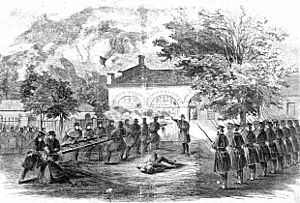John Brown's raid on Harpers Ferry facts for kids
Quick facts for kids John Brown's Raid on Harpers Ferry |
|||||||
|---|---|---|---|---|---|---|---|
| Part of pre-Civil War conflicts | |||||||
 Harper's Weekly illustration of U.S. Marines attacking John Brown's "Fort" Teresa Baine |
|||||||
|
|||||||
| Belligerents | |||||||
| Abolitionist Insurgents | |||||||
| Commanders and leaders | |||||||
| Robert E. Lee Israel Greene |
John Brown | ||||||
| Strength | |||||||
| 88 U.S. Marines Unknown number of Virginia Militia and Maryland Militia |
8 white men 12 free black men 1 freed slave 1 fugitive slave |
||||||
| Casualties and losses | |||||||
| U.S. Marines: 1 killed 1 wounded Virginia and Maryland Militia: Unknown |
10 killed 7 captured 5 escaped |
||||||
| Civilians: 6 killed 9 wounded |
|||||||
John Brown's raid on Harpers Ferry was an important event in American history. It happened in 1859, a few years before the American Civil War. A white man named John Brown wanted to end slavery in the United States. He planned to start a large revolt by enslaved people.
Brown and 21 of his followers attacked the United States arsenal (a place where weapons are stored) in Harpers Ferry, Virginia. His plan was to take weapons and give them to enslaved people so they could fight for their freedom.
However, Brown's raid did not go as planned. A group of U.S. Marines, led by Colonel Robert E. Lee, quickly stopped the attack. John Brown was captured. He had asked famous abolitionists like Harriet Tubman and Frederick Douglass to join him. But Tubman was sick, and Douglass believed the plan would fail.
Why John Brown Fought Slavery
John Brown grew up in a very religious family that was strongly against slavery. He tried many different businesses, but most of them failed. When he was 42, he went bankrupt.
In 1837, Brown went to a meeting of people who wanted to end slavery, called abolitionists. This meeting changed his life. He publicly promised to destroy slavery. By 1848, he was already making plans for a rebellion.
Brown believed that violence was necessary to end slavery. In 1856, he and some of his sons and followers killed five unarmed men and boys. This was in return for an attack by pro-slavery groups on the town of Lawrence, Kansas. This event was called the Pottawatomie massacre. It started a violent period known as Bleeding Kansas. Later, Brown and his men fought against a larger group of pro-slavery fighters at the Battle of Osawatomie. Two years after that, Brown and his men went into Missouri and freed 11 enslaved people. They also took wagons, horses, and mules.
The Harpers Ferry Attack
John Brown first planned to create a hidden base in the Blue Ridge Mountains. From there, he and his followers would help enslaved people escape. They would also launch attacks on slaveholders. He told other abolitionists about this plan, hoping they would give him money.
But his plan changed. By 1858, Brown had some money and men, but one of his followers told others about his plan. This forced Brown to hide for a year. After a year, he was ready to try again. He rented a farm in Maryland, across the river from Harpers Ferry. However, many of his original followers had changed their minds.
On October 16, 1859, Brown and his 21 men set out for Harpers Ferry. Around 4 am on October 17, they arrived. They cut the telegraph lines to stop news from spreading. Then, they captured the federal armory, which was full of weapons. Next, they took over Hall's Rifle Works, another place that made weapons for the government. Brown and his men also took 60 important local citizens as hostages.
Brown hoped that many enslaved people would join his fight, but none came. Later that morning, the local militia arrived. They trapped Brown and his men inside the armory's engine house. In the afternoon, U.S. Marines, led by Colonel Robert E. Lee, arrived. The Marines attacked the engine house, killing several of Brown's men. They captured John Brown.
Brown was quickly put on trial for his actions. He was found guilty and sentenced to death. He was hanged on December 2, 1859.
What Happened Next
After the raid, Colonel Lee and others searched the area for any of Brown's followers who had escaped. Few got away, but some were hidden by abolitionists in the North.
John Brown was taken to the courthouse in nearby Charles Town for his trial. He was found guilty and hanged on December 2. A famous actor named John Wilkes Booth, who later assassinated President Abraham Lincoln, was there to witness the execution.
John Brown quickly became a hero for the abolitionist cause. Many people said his death helped the anti-slavery movement more than his actions in life. In the Southern states, his raid made their worst fears come true. It showed them how strong the anti-slavery movement in the North had become.
Here's what happened to some of the U.S. Marines who were at Harpers Ferry:
- Robert E. Lee left the U.S. Army in 1861. He became the commander of the Confederate Army of America during the Civil War.
- Jeb Stuart also joined the Confederate Army and became their Chief of Cavalry (soldiers on horseback).
- Israel Greene resigned from the U.S. Army and joined the Confederacy. He became a Captain in the Confederate Marines and later a Major.
- Major Russel was the only officer who did not join the Confederacy. He was a Paymaster for the U.S. Marine Corps and died in 1862.
Images for kids
-
John Brown wrote a final statement on December 2 of 1859.





